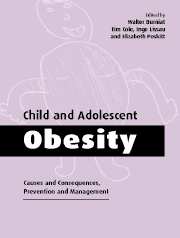Book contents
- Frontmatter
- Contents
- List of contributors
- Foreword
- Preface
- Part I Causes
- Part II Consequences
- Part III Prevention and management
- 12 Prevention
- 13 Home-based management
- 14 Dietary management
- 15 Management through activity
- 16 Psychotherapy
- 17 Drug therapy
- 18 Surgical treatment
- 19 Interdisciplinary outpatient management
- 20 Interdisciplinary residential management
- 21 The future
- Index
14 - Dietary management
Published online by Cambridge University Press: 02 November 2009
- Frontmatter
- Contents
- List of contributors
- Foreword
- Preface
- Part I Causes
- Part II Consequences
- Part III Prevention and management
- 12 Prevention
- 13 Home-based management
- 14 Dietary management
- 15 Management through activity
- 16 Psychotherapy
- 17 Drug therapy
- 18 Surgical treatment
- 19 Interdisciplinary outpatient management
- 20 Interdisciplinary residential management
- 21 The future
- Index
Summary
Introduction
Why diet? Obesity is the consequence of a patchwork of environmental factors and specific genetic and biological features. Nutrition is only one environmental factor, albeit an important one (Chapter 4). In this chapter we:
review studies presenting with dietary programmes from the 1950s;
discuss and compare the evolution of the nutritional procedures;
evaluate the positive and negative effects of dieting;
propose nutritional guidelines related to different clinical situations.
History of dietary therapy
In 1957, Hoffman reported on the treatment of 60 obese children and adolescents, 30 boys and 30 girls (age range 5.4–16.3 years). The average excess weight was respectively, 47.9% and 42.9% above average for the age. The dietary instructions were those of a classic low-calorie diet. At 4 months, mean weight losses were 27% (range: 7.3–66.4%) body weight in boys and 18.3% (range: 3.5–51.8%) body weight in girls. The wide range in individual weight losses can be appreciated in this early paper and remains a feature of most more recent studies. Hoffman's 1957 paper can be considered a pioneering study but it is quite empirical and confused. The author limited fruit intakes with the aim of avoiding ‘simple sugar’. Various anorexigenic drugs were prescribed. These were largely dexedrine sulphate and amphetamine but in some cases combined with amylobarbital. So, it is not clear how much the diet or the drugs were the main determinants of the weight losses observed. Further, there were no follow-up data.
Following Hoffman's paper and until the end of the 1970s, a number of other publications appeared presenting the effects of low-calorie diets (LCD) and/or simple nutritional counselling.
- Type
- Chapter
- Information
- Child and Adolescent ObesityCauses and Consequences, Prevention and Management, pp. 282 - 306Publisher: Cambridge University PressPrint publication year: 2002
- 7
- Cited by



